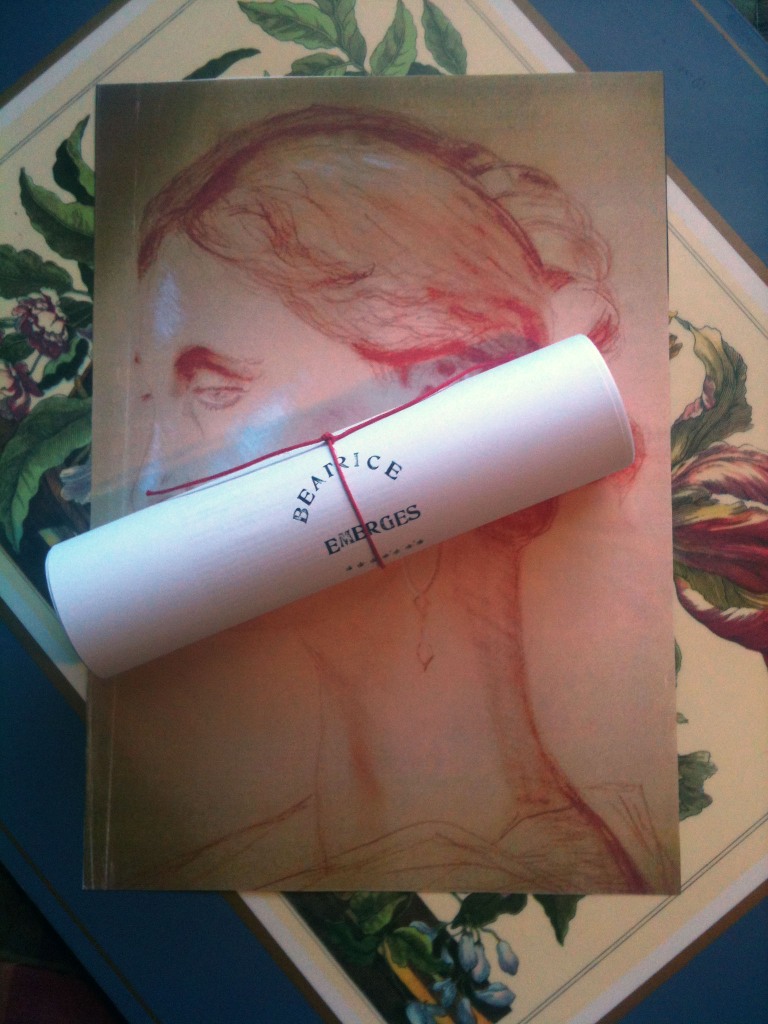Beatrice Emerges
By Kathi Stafford (ed.) with Millicent Borges Accardi, Susan Rogers, Jennifer Smith, Maja Trochimczyk
To download & assemble this chapbook, click here.
Deformation Statement by Kathi Stafford
I’ll never forget how dismayed I was to learn as a teenager that Shakespeare did not originate the romance between Romeo and Juliet. He’d actually picked up the story, fairly full-blown, from an Italian story-teller. In fact, Dante mentions the Capulets and the Montagues in the Divine Comedy, interestingly enough. Not only that—the origins stretch back  to Ovid’s Metamorphosis, where several similar tenets show up to thwart true love, including parents who hate each other, a faked death, and generational angst.
to Ovid’s Metamorphosis, where several similar tenets show up to thwart true love, including parents who hate each other, a faked death, and generational angst.
For this particular chapbook, Beatrice Emerges, the focus began with several phrases and words from the Divine Comedy, by Dante Alighieri, and similar texts: color as of fire; the ladies seven; a dark shadow’s edge; green leaves and branches black; lavender veils; shimmering gold; beatific portrait; and dowry cost. Dante saw Beatrice at a young age and fell under a sort of indescribable spell. It was called courtly love at the time—now, we might call it love from afar, or an unrequited passion. Beatrice (perhaps never knowing of Dante’s feelings for her) married another man, then died young, whereas Dante married another woman to whom he had been betrothed for years. None of these intervening facts stopped him from claiming Beatrice as his one great muse. She is a key figure in in the Divine Comedy—the only person pure enough to escort Dante through Heaven after he has traipsed about through both Hell and Purgatory.
Instead of resenting Shakespeare’s deformations of Ovid and Dante, I’ve now learned to appreciate how plots and characters are recycled by writers and artists across centuries. In the spirit of deformation, the contributors to Beatrice Emerges utilize a few constant starting points for pulling together words and images from earlier artists into a compost pile of ideas, stirred up, pressed down, and mined for new twists on the idea of this particular woman. Deformation of images and symbols allowed for a reclaiming of the mysterious and inspiring Beatrice.
The second focus built on Beatrice’s role as muse, a role that women have filled historically. What would she have thought about Dante’s use of her being as the inspiration of some of the greatest poetry ever to be written in the Italian language? What, in fact, is the true role and perception of the muse herself in this process? Beatrice became ultimately unobtainable to the artist, but he still claimed her deeply and passionately.
Art builds upon earlier art in myriad and unexpected forms, as shown in the “Galerie de Difformité.” A cut-up poem from the project becomes a bracelet on an arm, or sprigs of grass spring up in a tender field. The mash-up between visual drawings and paintings, performance art, written words, and collage has grown exponentially during the course of this undertaking. Beatrice comes into focus as the muse who reflects the kaleidoscope of perfect beauty and virtue that is deformed and reformed in a new century. Beatrice comes into focus as the muse who reflects the kaleidoscope of perfect beauty and virtue that is deforming and reforming in a new century—never attainable, changing over time in the eye of each beholder. Centuries after Dante followed Beatrice, we follow her, still.
 Image: “Overlapping Moments” by Susan Rogers
Image: “Overlapping Moments” by Susan Rogers
Instructions for Assembly:
1. This document is a PDF.
2. From the PDF print menu choose the Page Scaling pop-up.
3. Choose Multiple Pages Per Sheet.
4. From the Multiple Pages Per Sheet menu, select the value 2.
5. Print out each double page of the pdf file.
6. Cut the pages apart with scissors or a paper-cutter.
7. Assemble the pages in the order of this document.
8. Roll the assembled pages into a scroll with the front cover on the outside.
9. Take a long thread or cord and tie the scroll as you would a gift with a bow. Scrolls are the ancestors of the book—thus, the work creates a link back in time.
_______________________________
For more of Kathi’s work, see Exhibits G & M in the Galerie de Difformité. To view other chapbooks that are growing in & out of the Galerie de Difformité, please see the Directory.